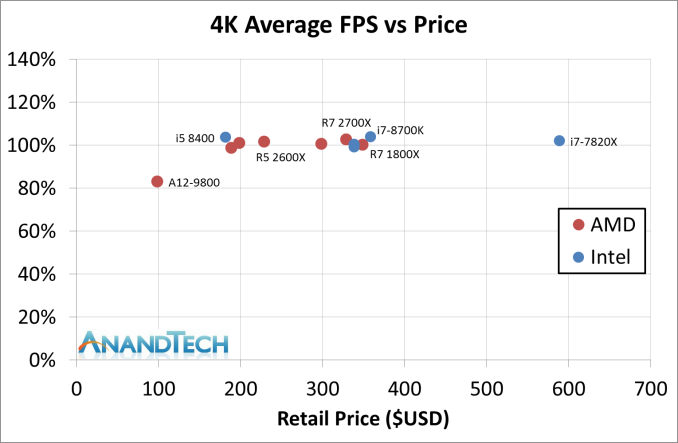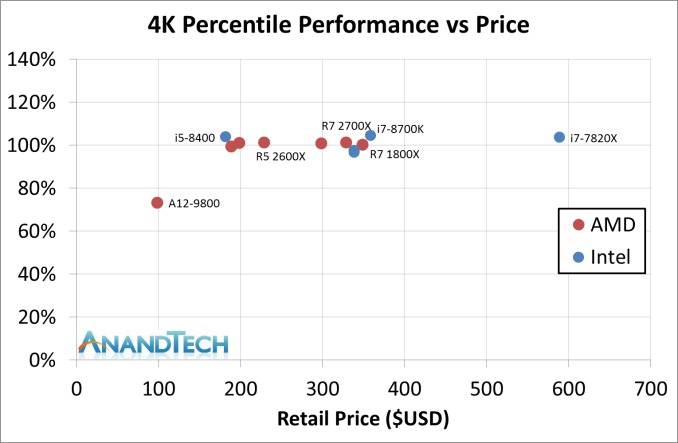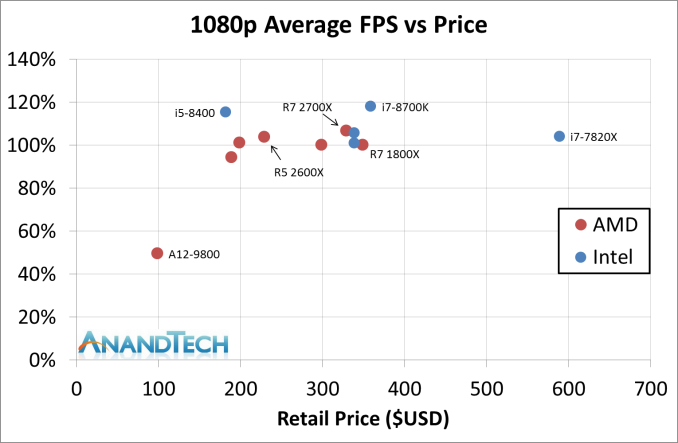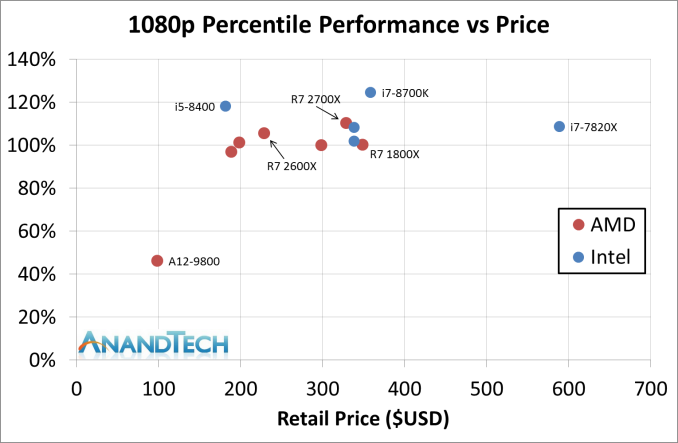The AMD 2nd Gen Ryzen Deep Dive: The 2700X, 2700, 2600X, and 2600 Tested
by Ian Cutress on April 19, 2018 9:00 AM ESTConclusion: Catching the Incumbent
Throughout AMD’s journey with Zen, the goal of high-performance x86 compute has two goals: be competitive, and be the best. Without a doubt the first generation of Ryzen certainly succeeded in being competitive, with analysts and outlets showing Ryzen processors in top selling lists, and review benchmarks putting the top AMD chips competitively against Intel’s high-end desktop parts. The goal, for the next few years, is to grab that low hanging microarchitectural fruit, and to taking advantage of new process nodes as time goes on. First stage is Ryzen’s second generation, known as the Ryzen-2000 series.
In this review we’ve shown that AMD met its goal of an additional 3% raw performance gain, with our benchmarks showing +3.1%. Combining this with the frequency increases derived from the GlobalFoundries 12nm manufacturing process, and turbo features such as Precision Turbo Boost making the most of thermal limits in an intuitive way, AMD also hit its 10% performance gain between generations. This doesn’t sound like much in all honesty, as on the surface this seems little more than an improved manufacturing bump plus some intelligent reduction in cache latency – if this was Intel, we’d be crying out for a big and brash gain in performance, but AMD is still riding the Zen design train and the focus is on the next full microarchitectural update in Zen 2, so most users and journalists are giving AMD a certifiable thumbs up at this point hoping to see a bigger jump next time around.
4K Gaming Analysis
However, everyone wants to know about the Ryzen 2000-series results. We start with gaming, and first up in our Performance/Price graphs is the high-end 4K gaming results. Our results take the R7 1800X as the base ‘100%’ and we take the geometric mean over all of our gaming tests at 4K.
Across the board, the new Ryzen 2000-series processors improved over the Ryzen 7 1800X, even the Ryzen 5 2600, from 1-3%. The Intel processors were 0-4% ahead of the 1800X, with both Coffee Lake processors being at that top 4%. In a GPU limited scenario here, there is some benefit to that single core performance for sure, however all the modern CPUs at a reasonable frequency seem plenty to get through.
For 99th percentile graphs, the new AMD processors either draw level or narrowly beat the Ryzen 1000-series. For our Intel tests, the 6700K/7700K previous generations are both down 3% over the 1800X, but the others are up 4% over the 1800X. Intel pushing Coffee Lake has helped it get that top spot, but all the processors (except Bristol Ridge, the A12-9800) perform pretty much equal again.
1080p Gaming Analysis
The key aspect for some users is in the lower resolution gaming: 1920x1080 is still the resolution that dominates the gaming charts, no matter how much us enthusiasts like to push for more pixels. Some readers reached out to us stating that they still buy the best graphics card but run at 200+ FPS at low resolutions, just for responsiveness. Running at lower resolution is a poor indication of future CPU performance, but what matters is the real world numbers that we are seeing today.
At this resolution, the Ryzen 7 2700X pushes an average +7% over the previous generation 1800X, and the new 65W parts easily matching the 1800X as well. Users who were looking at the budget friendly Ryzen 5 1600, the best seller for AMD last year according to some reports, can now look at the 2600 for +7% or 2600X for a +10% gain over the 1600.
However, Intel pulls out a win here. Through the higher IPC and clock speed, the Coffee Lake processors are 8-10% over Ryzen 7 2700X, ranging from +3% to +25% depending on the title. By contrast, our results do show that the Ryzen 7 2700X blasts past the older Intel generation processors, maing the 2700X win by a small margin to Kaby Lake and a 5%+ margin to Skylake.
The 99th percentile graph at 1080p looks like a stretched out version of the average frame rate graph, and this is broadly accurate: the processors better at 1080p perform even better on percentiles. Out of all the metrics AMD needs to be competitive on, this is the one where the new performance boost works best, but there is still work to do. This will, in all honesty, look better if and when AMD can match Intel on frequency. AMD also has a deficit in main memory DRAM latency, which we have cited as a factor in previous testing for 99th percentile frame rates. It will be interesting if AMD pushes ahead with a higher supported memory frequency quicker than Intel, because that would help here.
Workstation Analysis
For mainstream processor lines, with Ryzen-1000, AMD put eight cores and sixteen threads against Intel’s Kaby Lake with four cores and eight threads. This time around Intel has moved up to six cores with Coffee Lake, making it 12 on Intel vs. 16 on AMD, and pumped some more turbo frequency as well, but Intel is pushing the power budget beyond the box rating by a considerable margin by comparison. In the mid-range, where it was four threads against twelve, it is now six against twelve, however again Intel hits the higher frequencies.
In our single threaded benchmarks, the new Ryzen-2000 series now does match Intel’s Skylake processors for performance. In the last round of comparisons, Intel still had some advantage, but now the two are equal. Unfortunately for AMD, Intel is two further ‘generations’ ahead, through Kaby Lake and Coffee Lake, which mainly add in single core performance through additional frequency. This means that a Core i5-8400 does beat the best AMD has in single thread, and the Core i7-8770K rules the roost.
In multi-threaded workloads, a number of additional variables come into play. The nature of the threading in each core, such as which parts of the core are dynamic or statically partitioned, come into play, along with how memory and cache are managed. Here AMD has been aggressive in low level cache latency and size, however the AMD L3 non-inclusive cache is transposed against Intel’s L3 write-back cache which is more useful, as well as lower latency main memory.
What we see here on the AMD side is that only the Ryzen 7 2700X eclipses the old Ryzen 7 1800X, with the 2700 close behind. In this price bracket, the higher thread count of the AMD chip gives it a healthy lead over the Coffee Lake i7-8700K, and it also eclipses the eight-core Skylake-X Core i7-7820X in most tests. What is very clear however is that the previous generation Intel parts, the i7-6700K and i7-7700K, sit very much behind the competition, and even behind AMD’s cheapest second generation Ryzen processor, the Ryzen 5 2600.
If someone had said a few years ago that AMD would design a second generation Ryzen processor in 2018 that would eclipse all of Intel’s Skylake and Kaby Lake processors, I would have laughed. But here we are, and it speaks to AMD’s execution. If a user wants a chip for a multi-threaded workload, the $199 Ryzen 5 2600 is the best budget performer on the market today.
In that mid-range price battle, the Ryzen 5 2600 also gives a swift kick to the Core i5-8400. It is a non-contest.
Overall Thoughts
You Win Some, You Lose Some, But Customers Win
When competition exists, each product needs to put its best foot forward. Tackling an incumbent is hard, with their existing relationships and high budgets, but forcing them to react is seen as a win for customers. A criticism levied at Intel in recent years is stagnation – minor process updates while waiting for a new process node; with so many eggs in the basket for future generation products, anything equally competitive can start to look attractive in the market. Those inside the industry can tell that while Intel is iterating on similar 14nm designs each year while waiting for 10nm to come to market, AMD is putting its best foot forward with Zen and Ryzen on 14nm, now with Ryzen 2 on GF 12nm.
Boiling down to simple recommendations this time around is actually going to be fairly easy.
Any users that would like high single threaded performance, or high performing 1080p gaming using a mid-range GPU, then Intel’s Core i5-8400 is going to fit the bill.
For hardcore enthusiasts, running high-end graphics at 4K or like getting their general compute on, the Ryzen 2000-series is looking the best choice. At each price point AMD can fit anyone’s 4K gaming needs and win in raw instruction throughput.
AMD also bundles a half-decent stock cooler in the box, something Intel has neglected in recent years, making the product even more attractive.
















545 Comments
View All Comments
Vesperan - Sunday, April 22, 2018 - link
If by 'pulling a number out of thin air' you mean that I looked at the same steam hardware survey as you did and also a (year old) TechReport survey (https://techreport.com/news/31542/poll-what-the-re... ) - then yes, I absolutely pulled a number out of thin air. I actually think 10% of the entire market as a max for x1080 resolution and high refresh rate monitors will be significantly too high, as the market will have a lot of old or cheap monitors out there.The fact is, once you say Ryzen is perfectly fine for x1080 (at 60 hz) gaming and anything at or above x1440 because your GPU limited (and I'm not saying there is no difference - but is it significant enough?), the argument is no longer 'Ryzen is worse at gaming', but is instead 'Ryzen is just as good for gaming as Intel counterparts, unless you have a high refresh rate x1080 monitor and high end graphics card.'
Which is a bloody corner case. It might be an important one to a bunch of people, but as I said - it is a distinct minority and it is nonsensical to condemn or praise a CPU architecture for gaming in general because of one corner case. The conclusion is too general and sweeping.
Targon - Monday, April 23, 2018 - link
This is where current benchmarks, other than the turn length benchmark in Civ 6, are not doing enough to show where slowdowns come from. Framerates don't matter as much if the game adds complexity based on CPU processing capability. AI in games for example, will benefit from additional CPU cores(when you don't use your maxed out video card for AI of course).I agree that game framerates as the end all, be all that people look at is far too limited, and we do see other things, Cinebench for example, that help expand things, but doesn't go far enough. I just know that I personally find anything below 8-cores will feel sluggish with the number of programs I tend to run at once.
GreenReaper - Wednesday, April 25, 2018 - link
Monitors in use do lag the market. All of my standalone monitors are over a decade old. My laptop and tablet are over five years old. Many people have 4K TVs, but rarely hook them up to their PC.It's hard to tell, of course, because some browsers don't fully-communicate display capabilities, but 1920x1080 is a popular resolution with maybe 22.5% of the market on it (judging by the web stats of a large art website I run). Another ~13.5% is on 1366x768.
I think it's safe to say that only ~5% have larger than 1080p - 2560x1440 has kinda taken off with gamers, but even then it only has 3.5% in the Steam survey - and of course, this mainly counts new installations. 4K is closer to 0.3%.
Performance for resolutions not in use *now* may matter for a new CPU because you might well want to pair it with a new monitor and video card down the road. You're buying a future capability - maybe you don't need HEVC 10-bit 4K 60FPS decode now, but you might later. However, it could be a better bet to upgrade the CPU/GPU later, especially since we may see AV1 in use by then.
Buying capabilities for the future is more important for laptops and all-in-one boxes, since they're least likely to be upgradable - Thunderbolt and USB display solutions aside.
Bourinos - Friday, April 20, 2018 - link
Streaming at 144Hz? Are you mad???Luckz - Monday, April 23, 2018 - link
Would be gaming in 144 Hz while streaming 60 Hz, unless in Akkuma's fantasy world of 240 Hz monitors, the majority of stream viewers would want 144 Hz streams too ;)Shaheen Misra - Sunday, April 22, 2018 - link
Thats a great point. Every time i have upgraded it has been due to me not hitting 60fps. I have no interest in 144hz/240hz monitors. Had a Q9400 till GTA IV released. Bought a FX 8300 due to lag. Used that till COD WW2 stuttered (Still not sure why really). Now i own a 7700k paired with a 1060 6gb. Not the kind of thing you should say out loud but im not gonna buy a GTX 1080ti for 1080p/60HZ. The PCIe x16 slot is here to stay, i can upgrade whenever. The CPU socket on my Z270 board on the other hand is obsolete a year after purchase.Targon - Monday, April 23, 2018 - link
Just wait until you upgrade to 4k, at which point you will be waiting for a new generation of video card to come out, and then you find that even the new cards can't handle 4k terribly well. I agree about video card upgrades not making a lot of sense if you are not going above 1080p/60Hz.Luckz - Monday, April 23, 2018 - link
For 4K you've so far always needed SLI, and SLI was always either bad, bugged, or -as of recently- retired. Why they still make multi GPU mainboards and bundle SLI bridges is beyond me.Lolimaster - Thursday, April 19, 2018 - link
Zen2 should easily surpass the 200pts in CB15 ST, a minimum of 5-10% + a minum of 5-10% higher clocks, being extremely negative.Lolimaster - Thursday, April 19, 2018 - link
IPC and clock, no edit button gg.